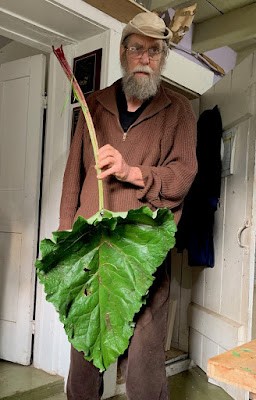by Fred Schueler and Aleta Karstad
Fragile Inheritance natural history
It’s getting to be the time of year when clothing and dogs may come back from outings knotted and bunched up with the hooky fruits of Burdock plants. These are species of the genus Arctium, native to Europe and Asia, but widely introduced across North America. The Burdocks are huge rhubarb‑leaved, biennial herbs in the Aster family. “Arctium” is from the Greek word for bear and refers to the appearance of the flowers, which are bristly spheres instead of ordinary daisy‑like Asters. The flowers mature as balls of hooked bracts that allow them to cling to clothing and animal fur. Bats and small birds are sometimes fatally trapped on the burrs, and the hooked burrs inspired the invention of Velcro in the early 1940s.
Locally, we have two species of Burdock, Arctium minus and A. lappa. A. minus, “Lesser Burdock,” credited by Wikipedia with 1.8 m height and 30 cm roots, was the only species around in the 1970s, but through the years we’ve tracked the regional spread of A. lappa (“Greater Burdock)” in Eastern Ontario, wikied at 3 m tall, with a 1 m root. The species are hard to tell apart until they flower, but the “Greater” burrs are larger and flatter‑topped and the plant is more sprawling. The “Lesser” burrs are smaller and more spherical, even somewhat pointed to the top at times, and the growth of the plant is more upright and conical. Once you know the differences in the burrs and in the way they’re deployed, you can pretty well identify fruiting plants while driving past at highway speeds.
We’ve recently engaged with Burdock because when Fred protested that it wasn’t an invasive species in eastern Ontario, he was put on the Burdock “Best Management Practices” team of the Ontario Invasive Plants Council. This plan is being funded by the city of Toronto, and being on the team has triggered us to notice that the Burdocks are much more abundant in Ottawa than in rural areas. This fits our idea that turkeys, the only birds that go after the Burdock seeds, may be controlling their abundance in rural areas. We don’t have Burdock observations from before turkeys arrived in the 1980s, but when we’re in New Brunswick, where Burdock is abundant all over the landscape, we record where the stands are to see if they decline as turkeys become abundant there.
Besides controlling the burrs as nuisances, we mostly relate to Burdocks as vegetables, and in the Orient they’re domesticated for this, and called “Gobo.” The huge taproots are delicious both after the plant dies back in the fall, and before it shoots up in the spring, with only three problems: the roots are so long that no matter how deeply you dig, you only seem to get half of the total volume of the root, the skin is so rough and dirty‑looking that it’s unappealing to peel, and in some older roots the flesh contains so much tough fibre that it has to be peeled to the more tender core. They’re best when cooked grated or sliced.
In the early spring, the first‑emerging shoots can be cooked as greens, or used fresh as a salad ingredient. In May and early June, as the stems get thick and tall and begin to leaf out, before the flowers form, we harvest the stems and peel them while the stem centre is still full and tender, before it becomes hollow and pithy.
The thick outer layer of even the heaviest young stems peels easily with a paring knife. We steam them, or boil them in just enough water to cover for about ten minutes. They have a slightly sweet flavour and are marvelously adaptable and nutritious in all kinds of dishes. We cut them up and toss them into stir fry, and they’re very nice used cold in bean salads. Of course, they’re great hot out of the pot with salt, butter and pepper, or mixed with cooked leafy greens.
So far, Burdock hasn’t taken over our Eastern Ontario garden, and we harvest the first‑year plants or cut most of the taller second year plants before their burrs are mature and ready to snag passersby. That way we can keep them to ourselves to admire and harvest, and they don’t get “shared” with those who haven’t yet learned to manage and use them.

